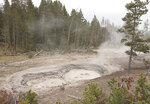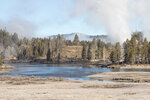Clear, 59° F
In the same way digital photography has evolved from 3 megapixel state-of-the-art professional DSLR cameras in the late 90s to folks now carrying 15 megapixel cameras in their cellphones, scientists …
This item is available in full to subscribers.
The Powell Tribune has expanded its online content. To continue reading, you will need to either log in to your subscriber account, or purchase a subscription.
If you are a current print subscriber, you can set up a free web account by clicking here.
If you already have a web account, but need to reset it, you can do so by clicking here.
If you would like to purchase a subscription click here.
Please log in to continue |
|


In the same way digital photography has evolved from 3 megapixel state-of-the-art professional DSLR cameras in the late 90s to folks now carrying 15 megapixel cameras in their cellphones, scientists are enjoying the benefits from vastly improved imaging, a leading expert studying the Yellowstone Volcano reports.
A team of researchers from the University of Utah, New Mexico University and the Institute of Earth Sciences in Taiwan in 2020 deployed 650 temporary seismometers in Yellowstone to measure seismic wave speeds in the subsurface of the caldera’s magma chamber. The massive deployment resulted in the best picture of the magma chamber ever seen and has led to interesting findings.
Important — though rarely discussed around work-place water coolers outside of those intended for scientists — the deployment provided a view at how magma waves behave; specifically if horizontally oriented waves of magma are faster or slower than vertically oriented ones.
“It helps us better understand what the magma chamber actually looks like; it's not a blob of partially molten material that is even throughout. Rather, it is almost stratified, with some partially molten sills towards the top,” said Mike Poland, scientist-in-charge of the Yellowstone Volcano Observatory, adding, “Quite frankly, it’s amazing that we are starting to achieve this level of [image] resolution.”
The research is important and could be used to better help save lives in the future as scientists work to understand geophysical structure and improve forecasts of eruptions and earthquakes. Yet, it is somewhat expensive.
The current seismic network in Yellowstone maintained by the University of Utah Seismograph Stations consists of about 40 stations, costing approximately $35,000 to $40,000 each. The 650 smaller seismographs used in the recent research each cost about $1,500.
The research also found that the percentage of semi-liquid or melt material in Yellowstone’s magma chamber is possibly higher than previously thought, suggesting it could be as high as 28%. It is the observation about the percentage of melt that has sparked concern by some outside the Yellowstone Volcano Observatory that the volcano might be closer to an eruption than previously thought.
But before you start prepping for the end of the world as we know it, the consensus is there are many thousands of years left before the super-volcano will erupt again — even among some of those who frequently post online videos with salacious headlines in the hopes of increasing their click rate through fear.
One such source published a video titled “Yellowstone is Closer to Erupting than Previously Thought” using footage of jarring eruptions to grab attention. While the video agrees that an eruption is a long way off, it does suggest (through a series of examples presented by an unidentified creator) that the increased amount of melt means an eruption is much closer than previously thought.
The problem with the statement, said Jamie Farrell, who is part of the research team and University of Utah seismologist, is that while there is believed to be a higher percentage of melt than previously thought, that doesn’t mean the amount is increasing.
“Even though the percent is larger, it doesn’t mean there is more or less now,” Farrell said.
The experts presented the study in the scientific journal “Earth and Planetary Science Letter” and wrote that despite the fact that the melt percentage is higher than previous estimates, it is still much lower than required to erupt.
Farrell said a melt percentage of 50% is needed for the magma to become mobile.
“More importantly, such improvement of understanding Yellowstone’s system has guided us in a promising direction to studying other volcanic systems on Earth. For instance, applying the same method at other volcanoes could provide important insights into how magma is stored in hazardous and frequently active systems — information that can improve eruption forecasts,” the team wrote in the July 31 edition of Caldera Chronicles, which is published by the U.S. Geological Survey.
The key to identifying reliable scientific information begins with looking for information provided by experts in the field that are properly sourced, not through social media posts that rely on their publications for a revenue stream, Poland said.
“If people stop watching this content, it means less income,” Poland said.
In attempts to keep the revenue flowing, salacious headlines are used to draw folks in. When misinformation is published, it can take a long time for scientists to correct the public’s misconceptions.
“I spend a tremendous amount of my time fighting that kind of misinformation. And I get a lot of questions from people like, why aren’t you reporting this?” he said.